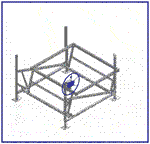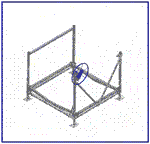Cantilever vs. Vertical. Which type of lift is best for you?

Cantilever lifts
Cantilever lifts have a simple design that reduces strain on cables and generally makes them fairly easy to maintain in good working order. They make use of leverage to raise the boat out of the water.
With a cantilever lift, the weight of the boat is transferred from the cradle through two H-shape structures to the base of the lift frame. The two H-shape structures lie almost flat in a horizontal position when the lift is down in the water, and are pulled by a cable into a vertical position in order to lift the boat up out of the water. This simple design allows for the use of a single cable at the front of the lift and just three pulleys.
With a cantilever lift, the cable is pulled either diagonally or horizontally (rather than straight up and down) and therefore never carries the full weight of the boat - the weight is carried by the two H-shaped levers. A cantilever lift actually gets easier to winch as the boat moves out of the water.
The main drawback to a cantilever lift is that the lift travel is limited by the height of the H-shape levers. Our cantilever lifts have 40" of lift travel. If you have a boat that requires 18" of water to float (as most stern drives do), a 40” lever is enough to raise it 22" above the water (40”- 18”= 22”), which is plenty for most but not all applications. If you need more lift - because you get very large waves on your lake or want to tuck your boat up tight under a high canopy - you should consider a vertical lift.
Some lift retailers suggest you should also consider a vertical lift if your shoreline is particularly shallow, but this is not true. Most cantilever lifts, like vertical lifts, will lower the lift cradle until it is nearly level with the base of the lift frame. Cantilever lifts may even have a slight advantage in very shallow water for two reasons. First, unlike a vertical lift, they do not need to be perfectly level, so there is a reduced need to raise the back end of the lift on the legs. Second, the carriage on a cantilever lift moves backward into deeper water as it drops.
Cantilever lifts have a simple design that reduces strain on cables and generally makes them fairly easy to maintain in good working order. They make use of leverage to raise the boat out of the water.
With a cantilever lift, the weight of the boat is transferred from the cradle through two H-shape structures to the base of the lift frame. The two H-shape structures lie almost flat in a horizontal position when the lift is down in the water, and are pulled by a cable into a vertical position in order to lift the boat up out of the water. This simple design allows for the use of a single cable at the front of the lift and just three pulleys.
With a cantilever lift, the cable is pulled either diagonally or horizontally (rather than straight up and down) and therefore never carries the full weight of the boat - the weight is carried by the two H-shaped levers. A cantilever lift actually gets easier to winch as the boat moves out of the water.
The main drawback to a cantilever lift is that the lift travel is limited by the height of the H-shape levers. Our cantilever lifts have 40" of lift travel. If you have a boat that requires 18" of water to float (as most stern drives do), a 40” lever is enough to raise it 22" above the water (40”- 18”= 22”), which is plenty for most but not all applications. If you need more lift - because you get very large waves on your lake or want to tuck your boat up tight under a high canopy - you should consider a vertical lift.
Some lift retailers suggest you should also consider a vertical lift if your shoreline is particularly shallow, but this is not true. Most cantilever lifts, like vertical lifts, will lower the lift cradle until it is nearly level with the base of the lift frame. Cantilever lifts may even have a slight advantage in very shallow water for two reasons. First, unlike a vertical lift, they do not need to be perfectly level, so there is a reduced need to raise the back end of the lift on the legs. Second, the carriage on a cantilever lift moves backward into deeper water as it drops.

Vertical lifts
Vertical lifts have a more complicated design and require slightly more effort to maintain, but will get your boat up very high above the water. Our vertical lifts provide 56” of lift travel which is enough to raise a typical sterndrive boat as much as 38”above the water (56”- 18”= 38”). The greater height provided by vertical lifts also means they are better suited to lakes with water levels that fluctuate a great deal because they don't have to be moved as often.
Vertical lifts raise the boat with cables which bear the full weight of the boat at all times. There area number of different ways that cables can be configured, but the most common involve 4 or 5 cables and 7 to10 pulleys. The cables run in Z patterns and are threaded through the hollow extrusions that make up the frame of the lift cradle. This front cable is attached to a winch and is the only cable that does any actual lifting; the other cables are there for balance and support.
As mentioned, vertical lifts require slightly more maintenance than cantilever lifts. First, they should be kept as close to level as possible (no more than 2” of variation between corners) to reduce the risk of the carriage binding against the frame, as well as premature cable wear. Second, the cables are prone to stretching over time (because they are bearing the weight of the boat) and need to be adjusted periodically to keep the carriage level. Third, cables may need to be replaced more frequently due to wear – especially the front cable which is the one which does all of the lifting. Most manufacturers suggest replacing cables every two to five years. Lastly, although both types of lifts need to kept free of weeds, this is especially true for vertical lifts. Vertical lifts have more places for weeds to gather and hide, and more pulleys that can jam up because of them. Owners of vertical lifts need to be particularly vigilant about cleaning weeds off after each time the lift is used.
Which type of lift is 'best'?
Sorry, there is no simple answer to this question. Both types of lift have their place. Cantilever lifts offer lower maintenance, but vertical lifts offer greater height. In the end, you are the best judge of which type is best for your shoreline. We offer this information so that your decision can be guided by facts rather than simply fashion.
Vertical lifts have a more complicated design and require slightly more effort to maintain, but will get your boat up very high above the water. Our vertical lifts provide 56” of lift travel which is enough to raise a typical sterndrive boat as much as 38”above the water (56”- 18”= 38”). The greater height provided by vertical lifts also means they are better suited to lakes with water levels that fluctuate a great deal because they don't have to be moved as often.
Vertical lifts raise the boat with cables which bear the full weight of the boat at all times. There area number of different ways that cables can be configured, but the most common involve 4 or 5 cables and 7 to10 pulleys. The cables run in Z patterns and are threaded through the hollow extrusions that make up the frame of the lift cradle. This front cable is attached to a winch and is the only cable that does any actual lifting; the other cables are there for balance and support.
As mentioned, vertical lifts require slightly more maintenance than cantilever lifts. First, they should be kept as close to level as possible (no more than 2” of variation between corners) to reduce the risk of the carriage binding against the frame, as well as premature cable wear. Second, the cables are prone to stretching over time (because they are bearing the weight of the boat) and need to be adjusted periodically to keep the carriage level. Third, cables may need to be replaced more frequently due to wear – especially the front cable which is the one which does all of the lifting. Most manufacturers suggest replacing cables every two to five years. Lastly, although both types of lifts need to kept free of weeds, this is especially true for vertical lifts. Vertical lifts have more places for weeds to gather and hide, and more pulleys that can jam up because of them. Owners of vertical lifts need to be particularly vigilant about cleaning weeds off after each time the lift is used.
Which type of lift is 'best'?
Sorry, there is no simple answer to this question. Both types of lift have their place. Cantilever lifts offer lower maintenance, but vertical lifts offer greater height. In the end, you are the best judge of which type is best for your shoreline. We offer this information so that your decision can be guided by facts rather than simply fashion.
